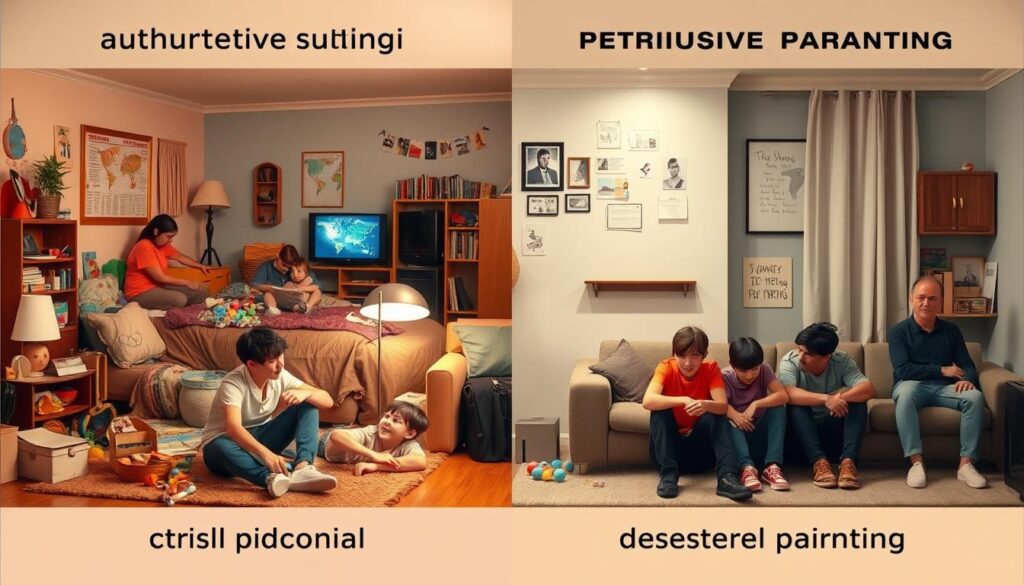I’ve studied adolescent psychology and observed how family structure affects teens. Impact of Family Structure on Teen Development is more significant than ever, as modern family dynamics have changed considerably, bringing both challenges and opportunities for teenagers in the U.S.
Family setup plays a crucial role in shaping a teen’s emotions, social life, and academic success. Every family type—traditional, single-parent, blended, or multi-generational—provides unique experiences that influence how teens develop and reach their full potential.
Teen development goes beyond statistics; each family situation presents distinct psychological and developmental factors that profoundly shape how adolescents navigate their formative years.
Key Takeaways
- Family structure directly influences teen emotional and psychological development
- Different household configurations create unique developmental experiences
- Understanding family dynamics helps support adolescent growth
- Teen development is multifaceted and context-dependent
- Supportive family environments are key for teens to thrive
Understanding Modern Family Dynamics and Teen Development
Family life has changed a lot in recent years. This change affects how teens grow up. Now, there are many different family types, breaking away from old ways.
Today’s teens face complex family situations. These situations greatly influence their growth and happiness. It’s key for parents and teachers to understand this to help teens develop well.
Traditional vs Contemporary Family Structures
Modern families are very different from the old nuclear families. Today, we see:
- Single-parent households
- Blended families
- Multi-generational homes
- Same-sex parent families
- Adoptive and foster families
Key Elements of Family Influence
| Family Dynamic | Impact on Adolescent Development |
|---|---|
| Communication Patterns | Shapes emotional intelligence and social skills |
| Emotional Support | Determines resilience and mental health |
| Parenting Styles | Influences behavior and decision-making |
Developmental Stages in Adolescence
Adolescence is a complex journey with many important milestones. Parenting styles are very important. They help teens develop their identity, confidence, and social skills.
“Families are the compass that guides us. They are the inspiration to reach great heights, and our comfort when we occasionally falter.” – Brad Henry
The Impact of Family Structure on Adolescent Development

Family structure greatly affects how teens grow up. It shapes their emotional, social, and thinking skills. This is because family life is where teens first learn about the world.
“The family is the first and most influential social environment for any teenager’s development.” – Dr. Elizabeth Roberts, Child Psychology Research Institute
Family setup has a big role in teen growth. It does this in many ways:
- Emotional support and attachment patterns
- Communication styles within the family
- Role modeling and behavioral expectations
- Stress management and resilience building
Studies show how family shape affects teens:
| Family Structure | Potential Impact on Teen Development |
|---|---|
| Nuclear Family | Consistent emotional stability |
| Single-Parent Household | Increased independence and adaptability |
| Blended Family | Complex social skill development |
But, teen development isn’t just about family. Things like personal strength, outside help, and drive also play a big part. What matters most is the quality of family bonds, not just who lives together.
This knowledge helps parents and teachers better support teens. It shows that every family is different, with its own chance for growth and learning.
How Different Parenting Styles Shape Teen Behavior
Parenting styles are key in shaping teen behavior and emotional growth. Each style has its own challenges and outcomes. These greatly affect how teens grow and feel.

Knowing about parenting styles can help families support their teens. This support can lead to positive behavior and emotional smarts.
Authoritative Parenting Outcomes
Authoritative parenting is the most balanced. It mixes high expectations with emotional support. This creates a caring yet structured place for teens.
- Promotes open communication
- Encourages independent thinking
- Builds strong emotional resilience
Permissive vs Strict Parenting Effects
“Parenting is not about control, but about guiding and understanding.”
Extreme parenting can harm teen behavior. Permissive parenting might lower self-discipline. Strict parenting can lead to rebellion and silence.
| Parenting Style | Teen Behavior Outcomes |
|---|---|
| Permissive | Reduced self-regulation, boundary issues |
| Strict | Emotional withdrawal, secrecy |
| Authoritative | Balanced emotional growth, better communication |
Co-Parenting Challenges and Solutions
Good co-parenting needs clear communication and shared plans. Teens do best when parents agree, no matter their relationship.
- Maintain consistent rules across households
- Communicate openly about teen behavior
- Prioritize the teen’s emotional well-being
By grasping these parenting dynamics, families can support healthy teen growth. This support is key for emotional and mental well-being.
Single-Parent Households: Challenges and Opportunities
Single-parent households face special challenges and chances for growth. When one parent takes on the main role, family life changes a lot. This change affects how teens grow up.
Teens in single-parent homes go through big changes. They often become more independent and resilient. This is different from teens in two-parent families.
“Single parenting isn’t about doing everything perfectly, but about creating a supportive and loving environment.” – Dr. Rachel Thompson, Family Psychologist
- Increased responsibility for teens
- Stronger emotional connections with the custodial parent
- Potential for accelerated personal growth
- Development of advanced problem-solving skills
Single-parent homes can be great for teens. They learn important skills like managing money and being self-reliant. These skills help them grow and succeed in life.
Good communication is key in single-parent families. Talking openly helps teens deal with feelings and build trust. Parents need to create a supportive space that values everyone’s strengths.
- Establishing consistent routines
- Maintaining transparent communication
- Seeking external support when needed
- Celebrating individual and family achievements
Single-parent families face unique hurdles but also offer great chances for teens to grow. With the right parenting and support, families can turn challenges into opportunities for growth.
Navigating Life in Blended Families
Blended families are complex and dynamic, challenging old ideas of family. Teens in these families face new emotional challenges with step-siblings and other relatives.

To find harmony in blended families, patience, understanding, and strategic connections are key.
Understanding Step-Sibling Relationships
Step-sibling relationships can be tough. Teens may feel a mix of emotions, from excitement to uncertainty, with new family members.
- Acknowledge individual feelings and experiences
- Create shared family activities
- Respect personal boundaries
- Develop open communication channels
Adapting to New Family Members
Blended families need flexibility and empathy. Each person brings their own background, personality, and expectations.
“Families are not defined by blood, but by love and commitment.” – Anonymous
Building Strong Bonds
Building strong bonds in blended families takes effort. It’s important to create chances for meaningful interactions that build respect and understanding.
- Schedule regular family meetings
- Plan enjoyable group activities
- Practice active listening
- Celebrate individual and collective achievements
Thriving in blended families means making real connections, keeping open dialogue, and facing challenges with kindness and patience.
Socioeconomic Factors and Teen Development
Family dynamics are key to understanding how money affects teens. Teens from different economic levels face unique challenges. These shape their growth, opportunities, and future.
“Economic circumstances can significantly influence a teenager’s psychological and social development.” – Dr. Elizabeth Roberts, Child Development Researcher
Socioeconomic status shapes teen development in different ways. Families with less money often struggle to support their kids’ education and personal growth.
- Limited access to educational resources
- Reduced extracurricular opportunities
- Higher stress levels within family environment
- Potential financial strain affecting mental health
Research shows teens from wealthier families usually have more stable homes. These homes often offer:
- Better educational support
- Enhanced mental health resources
- Greater academic and personal development opportunities
| Socioeconomic Level | Educational Support | Emotional Well-being | Future Opportunities |
|---|---|---|---|
| Low Income | Limited | High Stress | Restricted |
| Middle Income | Moderate | Balanced | Expanding |
| High Income | Comprehensive | Stable | Extensive |
Understanding these dynamics helps parents and educators create supportive environments. This can help teens overcome socioeconomic challenges. By implementing strategic interventions, teens can develop resilience. This way, they can reach their full potentials, no matter their family’s economic status.
Mental Health and Academic Performance in Various Family Structures
Family dynamics greatly affect a teenager’s mental health and school success. The link between emotional support and school achievement shows how important family is for growing up.
Emotional Support Systems
Teens with supportive families tend to have better mental health. Studies show that emotional support helps students deal with stress and school work.
- Positive family communication reduces anxiety
- Emotional validation improves self-confidence
- Regular family interactions enhance psychological well-being
Educational Achievement Patterns
Family structure affects how well a student does in school. Different family setups create unique learning environments that impact school success.
| Family Structure | Average GPA | Academic Stress Level |
|---|---|---|
| Two-Parent Households | 3.4 | Low |
| Single-Parent Households | 3.1 | Moderate |
| Blended Families | 3.2 | High |
Stress Management Strategies
It’s vital for teens to learn how to handle stress. Proactive communication and structured support networks help them deal with tough family situations.
“Understanding family relationships is key to supporting teenage mental wellness and educational success.” – Dr. Sarah Thompson, Child Psychology Research Institute
Families can help their teens by talking openly, setting routines, and getting help when needed.
Conclusion
The impact of family structure on adolescent development is complex. My research shows that family dynamics greatly shape teen growth. Each family type has its own challenges and chances for growth.
Parenting styles, emotional support, and socioeconomic factors all play a role. They help teens navigate their important years. This is true for all family types.
For teens to thrive, families need to focus on open communication and emotional support. Whether it’s a single parent, blended family, or two-parent home, the quality of relationships matters. It’s the emotional environment that helps teens grow.
Parents, teachers, and community leaders must see the good in different family structures. By being flexible and supportive, we help teens reach their full potentials. Every family’s story adds to the rich tapestry of teen experiences.
This tapestry helps shape confident, resilient young adults ready for the future. As we learn more about family dynamics and teen development, we find that there’s no single way to do it right. The most important thing is to support each teen’s unique journey to growth and self-discovery.



